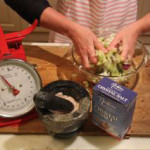. . . . .
 Hot off the heels of our recent post Why the Heck Would I Ferment Foods? (plus “13 Fabulous Fermented Food Recipes” coming tomorrow!) I thought I’d share my top 10 tips for fermenting foods…
Hot off the heels of our recent post Why the Heck Would I Ferment Foods? (plus “13 Fabulous Fermented Food Recipes” coming tomorrow!) I thought I’d share my top 10 tips for fermenting foods…
- It is important to use the best quality organic vegetables, fruits and proteins, sea salt and filtered or pure water for lacto-fermentation. Lactobacilli need plenty of nutrients to do their work; and, if the vegetables are deficient, the process of fermentation will not proceed. Likewise if your salt or water contains impurities, the quality of the final product will be compromised.
- For the first 2-4 days in general a room temperature of about 22 degrees Celsius (or 72 degrees Fahrenheit) will be sufficient to ensure lactic-acid fermentation takes place. More time will be needed if your kitchen is colder and less time if it is super warm.
- After 2-4 days at room temperature, the jars should be placed in a dark, cool spot, ideally one with a temperature of about 4 degrees Celsius (or 40 degrees Fahrenheit) for long-term preservation.
- Fruits and vegetables are first washed and cut up, mixed with salt and herbs or spices and then pounded briefly to release juices. They are then pressed into an air tight container.
- Salt inhibits putrefying bacteria for several days until enough lactic acid is produced to preserve the vegetables for many months. The amount of salt can be reduced or even eliminated if “whey” is added to the solution.
- Rich in lactic acid and lactic acid-producing bacteria, whey acts as an inoculant, reducing the time needed for sufficient lactic acid to be produced to ensure preservation. Use of whey will result in more consistently successful fermenting and the word is – it is ‘essential’ for fermenting fruits.
- About one inch of space should be left between the top of your fruits/vegetables with their liquid and the top of the jar, as the vegetables and their juices expand slightly during fermentation.
- Be sure to close the jars very tightly. Lacto-fermentation is an anaerobic process and the presence of oxygen, once fermentation has begun, will ruin the final product.
- Check on your fermenting food every day or two (this burps the jar as well). Open the jar, smell it, taste it with a clean fork and push the foods back down into its juices. After a few days the mixture should go bubbly and after another few days it should start to smell and taste sour. Eventually the formation of carbon dioxide will slow down and you won’t have to burp and check the jar any longer.
- Lacto-fermented vegetable condiments will keep for many months in cold storage but lacto-fermented fruits and preserves should be eaten within two months of preparation.
NOTE: Some lacto-fermented products may get bubbly, particularly the chutneys. This is natural and no cause for concern. Additionally often little spots of white foam appear at the top of the pickling liquid. They are completely harmless and can be lifted off with a spoon. The occasional batch that goes bad presents no danger BUT the smell will be so absolutely awful that nothing could persuade you to eat it. The sign of successful lacto-fermentation is that the vegetables and fruits remained preserved over several weeks or months of cold storage.
. . . . .
Yours in health…
Jennifer Barham-Floreani
Bach. Chiropractic, Bach. App Clinical Science
Registered internationally, no longer practicing as a chiropractor in Australia.


 Hot off the heels of our recent post
Hot off the heels of our recent post 
